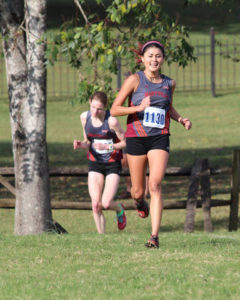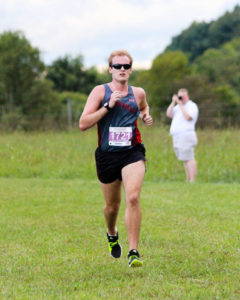Miles to go before I sleep: a reflection of the 2017 cross country season

Cross country takes place at an interesting time of year. We begin our season by running with minimal clothing and conclude our season in layers.
“Season” is an interesting term in the running community. Traditionally, winter is the indoor track season, followed by outdoor track in the spring. Because Maryville College does not have a track team, spring means speed to prepare the runner for the next six months. Summer means heavy mileage for building the stamina and endurance to make us faster than before.
At last, fall arrives. Cross country season is here. With the joys of longer runs to zone out, the cross-country athlete must also endure sustained fast-pace miles embedded in interval and tempo workouts.
Like all sports, cross country athletes spend time conditioning, which takes its form in both running and weight training. Six days a week are spent running on local trails and neighborhoods and taking the occasional trip to the weight room, formulaically increasing fitness. With busy summer schedules, training comes at its own price. Most high school programs meet as a team throughout the summer, whereas collegiate runners complete their mileage independently. Sometimes this means setting your own rigorous schedule to fulfill training requirements, showing dedication to the program.

“I had to find breaks during the day to get my mileage in,” said sophomore runner Chase Chastain. “Being the health director at a summer camp, I had to take advantage of the time I had to fulfill my training.”
Each year, preseason carries the eagerness and energy of new and experienced runners alike. This year, the team welcomed freshmen Lea Mulligan, Maddie Zawisza, and Andrew Amburn and juniors Kaitlyn Carringer and Taylor Williams to the family. This year, our first full day together consisted of a white-water rafting trip down the Hiwassee River as a team bonding experience. Anticipating 25 athletes to the program, the final roster consisted of 15 athletes – six men and nine women. As a young team, a lot of work needed to be done to be true competitors in the USA South Conference.
Traditionally, the team runs their first competition at Covenant College on the first Friday of classes. Due to construction on the course, the meet did not take place this year, and the Scots instead travelled to Tusculum College. Both the men and women ran a 5K, which differs from how the team usually begins their season with the men running a 5K and the women running a two-mile course. Taylor Williams was the first finisher on the women’s team, which is a feat for her first race with the Scots.

“I didn’t know what to expect because I didn’t have much experience racing, but knowing that I was running for a team helped motivate me to do well,” Williams said.
For myself, this was my first cross country race where I ran under 20 minutes in the 5K. I recall junior AnneMarie McDurmon shouting from off-course, “Keep going! That summer mileage is paying off!”
Once September rolls around, the women gear their training towards the 6K (3.73 miles) and the men shift to the 8K (4.98 miles). September also means 6:00 a.m. practices on Tuesday and Thursday mornings where the challenge is simply waking up and afternoon workouts on Mondays and Wednesdays where we build speed and stamina.
“I’ve always had a love/hate relationship with morning workouts,” said senior Chandler Chastain. “The idea of staying up late to finish homework and then running early in the morning is not my idea of fun. Morning workouts take up less time and free up afternoons, which is valuable for a college student. They also let us see one of the best sights on campus: sunrises over Lloyd beach. I can honestly say that it is one of the best sunrise spots in Blount County.”
The Berea Invitational was the second meet of the season, held in the middle of September, with the women running another 5K and the men running their first 8K of the season. The course is unique, as competitors run through a large field, cross a shallow creek and run through a trail system. The heat was also a challenge, however both teams excelled.

In October, the team competes three weekends in a row on some of the toughest courses in the South, and concludes the month with the Conference Championship, which was hosted by Piedmont College this year. During October, each week’s training corresponds with the course’s conditions, and emphasis is focused on maximum fitness for Conference.
October begins with a “home-field advantage.” The Maryville College Invitational is a staple of the program and is an event that runners both enjoy and dread. While not having to wake up extra early or travel overnight, the challenge lies in the steep hills and narrow trails.
Having a home course is “one of the greatest resources as a school and a team,” said Coach Tyson Murphy. “In one of my earlier years coaching here, I designed a two loop course that started and finished on Lloyd beach, which was spectator friendly and easy to follow as a racer. We used [the campus construction] as an opportunity to highlight our widest and safest trails as our attendance grew. The three loops we have now means the course is spectator friendly, safe, easy to mark and fast. It also drastically reduces our footprint in the College Woods and reduces our need to manage the single-track trails.”
The weekend after the home race, the team travelled down to Tallulah Falls, GA to compete in the toughest course of the season: Piedmont. The Scots ran this course twice in the past couple years, as this is where Conference is held.
This course consists of rolling, steep hills, which are run multiple times in the event. The previous year, the slowest times of the season were tallied at this course. Ironically, 90% of the team ran season bests or personal records at the preview meet due to lower temperatures and proper training.
“Piedmont is hilly compared to other courses I’ve run,”Mulligan said. “ I really like it because it has a lot of variety, running through woods and fields with a view of a pond. I think races are more fun when they’re not only on grassy fields.”
Unlike most sports where each team is weighted per game, all of our season efforts are based on one race: Conference. With a young team on the men’s side, the goal was to finish as high as possible, and the women’s team attempted to score in the top five. With fresher air, lower temperatures, and even some rain, almost all of the team set personal bests and ran faster times than three weeks prior. Sophomore Susanna Cook dropped over a minute off her previous personal best, set at the Piedmont course the year before.
“I found that I was capable of pushing my body to a whole new level,” said Cook. “When I saw my time, I knew it paid off to embrace the pain instead of fearing it. It seemed worthwhile when I saw what I had accomplished for my team.”
Both teams ended up scoring fifth place. Women’s accolades included Susanna Cook receiving second team All-Conference, Taylor Williams receiving third team All-Conference, and Kaitlyn Carringer receiving Honorable Mention All-Conference. Williams was also the recipient for the All-Sportsmanship Team.
Men’s accolades included Daniel Beckett receiving first team All-Conference and myself receiving the All-Sportsmanship Team.
This year, both men and women wrapped up their season eight hours away for the South/Southeast DIII Cross Country Championships. The first two days felt like a getaway as we previewed the course at Christopher Newport University and spent the afternoon at Fort Monroe, in awe of the beach, setting sun and the site’s historic significance.
The temperature on the morning of the race was 38 degrees, the coldest the weather had been all season. The men’s race was a spectacle, featuring 222 of the best runners in the southeast. A noteworthy performance was from Daniel Beckett, who shattered the school’s 8K record by 42 seconds.
“I don’t think it could’ve gone much better,” Beckett said. “I was boxed in the first mile and panicked, thinking that I started out too slow. By the 5K mark, I began charging to catch up, and I sealed the deal in the final half mile.”
He also said that he trained much smarter this season, pushing himself to reach his goals through his mindset and coaching.
I also had a noteworthy performance, breaking my 5K record and 8K record in one event. I was nervous entering the competition and stunned when I saw my final time, dropping almost a minute and a half off of my previous personal best.
On the women’s side, the team set a new school record for the team average, with an average 6K finish of 25:54.
Overall, the cross country team experienced a highly successful season with improved times among returning runners and continuous personal bests for athletes new to the collegiate scene. For now, it is time for us to rest and look ahead to the next time we lace up our shoes and lose ourselves in miles of trails.

